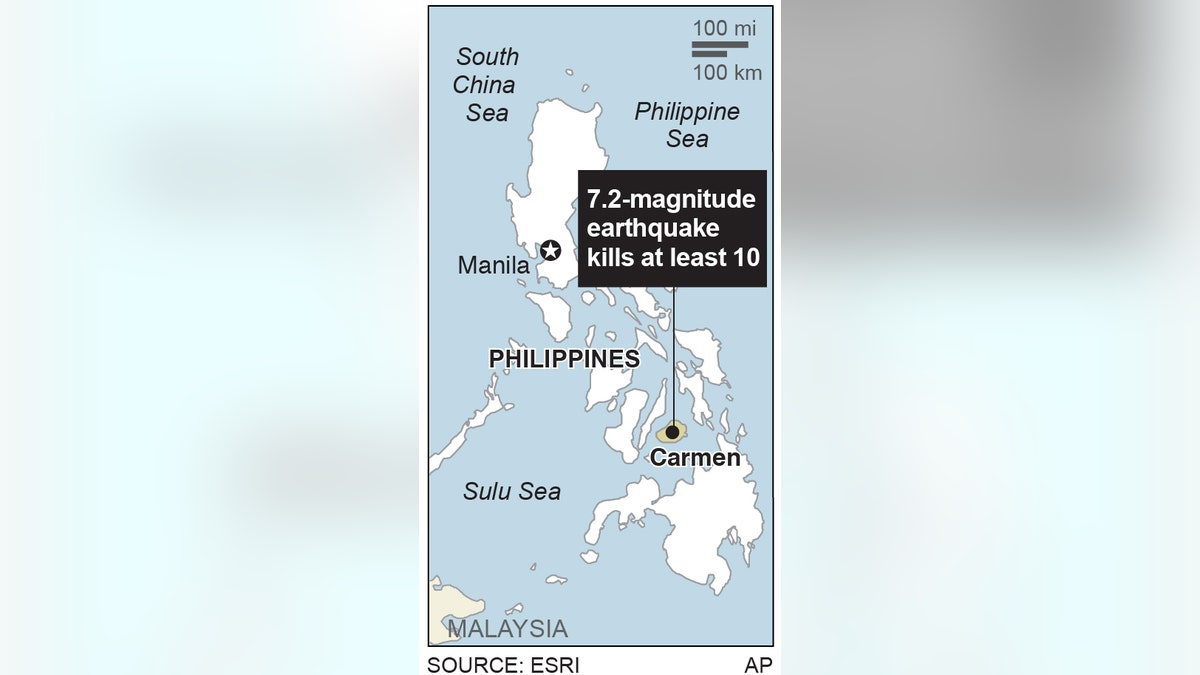
Map locates the city of Carmen in the Philippines; 1c x 3 inches; 46.5 mm x 76 mm; (The Associated Press)
MANILA, Philippines – A 7.2-magnitude earthquake collapsed buildings, cracked roads and toppled the bell tower of the Philippines' oldest church Tuesday morning, killing at least 20 people across the central region.
The quake sent people rushing out of homes and buildings, including hospitals, as aftershocks continued. At least five died in a stampede in Cebu, said Neil Sanchez, provincial disaster management officer.
Offices and schools were closed for a national holiday, which may have saved lives.
The temblor, which struck at 8:12 a.m., was centered about 33 kilometers (20 miles) below Carmen town on Bohol Island and did not cause a tsunami.
Four people were killed in Bohol and 15 died in Cebu province, a more urban and densely populated region across the strait from the earthquake's epicenter, said Civil defense spokesman Maj. Reynaldo Balido. Another person died on Siquijor Island, southwest of Bohol. A total of 33 were injured.
In Cebu, a boat ride from Bohol, five were killed when a fishing port collapsed. Two more people died and 19 were injured when the roof of a market in Mandaue in Cebu province fell on them. Elsewhere in the city, a woman died after being hit on the head when the quake toppled a building.
Photos from Cebu broadcast on TV stations showed a fallen concrete 2-story building, and reports said an 8-month-old baby and a second person were pulled out alive.
"It's fortunate that many offices and schools are closed due to the holiday," said Jade Ponce, the Cebu mayor's assistant.
He said patients at the city's hospitals were evacuated to basketball courts and other open spaces "but we'll move them back as soon as the buildings are declared safe."
Historic churches suffered the most damage, including the country's oldest, the Basilica of the Holy Child in Cebu, which lost its bell tower.
A 17th-century limestone church in Loboc town, southwest of Carmen, crumbled to pieces, with nearly half of it reduced to rubble. Other old churches dating from the Spanish colonial period, which are common in the central region, also reported damage.
Cebu province, about 570 kilometers (350 miles) south of Manila, has a population of more than 2.6 million people. Nearby Bohol has 1.2 million people and is popular among foreigners because of its beach and island resorts and the Chocolate Hills.
Vilma Yorong, a Bohol provincial government employee, said she was in a village hall in Maribojoc town when "the lights suddenly went out and we felt the earthquake."
"We ran out of the building, and outside, we hugged trees because the tremors were so strong," she told The Associated Press by phone. "When the shaking stopped, I ran to the street and there I saw several injured people. Some were saying their church has collapsed."
She said that she and the others ran up a mountain fearing a tsunami would follow the quake. "Minutes after the earthquake, people were pushing each other to go up the hill," she said.
Tuesday is a national holiday for the Muslim festival of Eid al-Adha, and that may have reduced casualties. The earthquake also was deeper below the surface than the 6.9-magnitude temblor last year in waters near Negros Island, also in the central Philippines, that killed nearly 100 people.
Regional military commander Lt. Gen. Roy Deveraturda said that he recalled soldiers from the holiday furlough to respond to the quake. He said it damaged the pier in Tagbilaran and caused some cracks at Cebu's international airport but that navy ships and air force planes could use alternative ports to help out.
Passenger flights were put on hold until officials check runways and buildings for damage.
Earthquakes are common in the Philippines, which lies along the Pacific "Ring of Fire."
___
Associated Press writers Hrvoje Hranjski, Teresa Cerojano and Jim Gomez contributed to this report.
